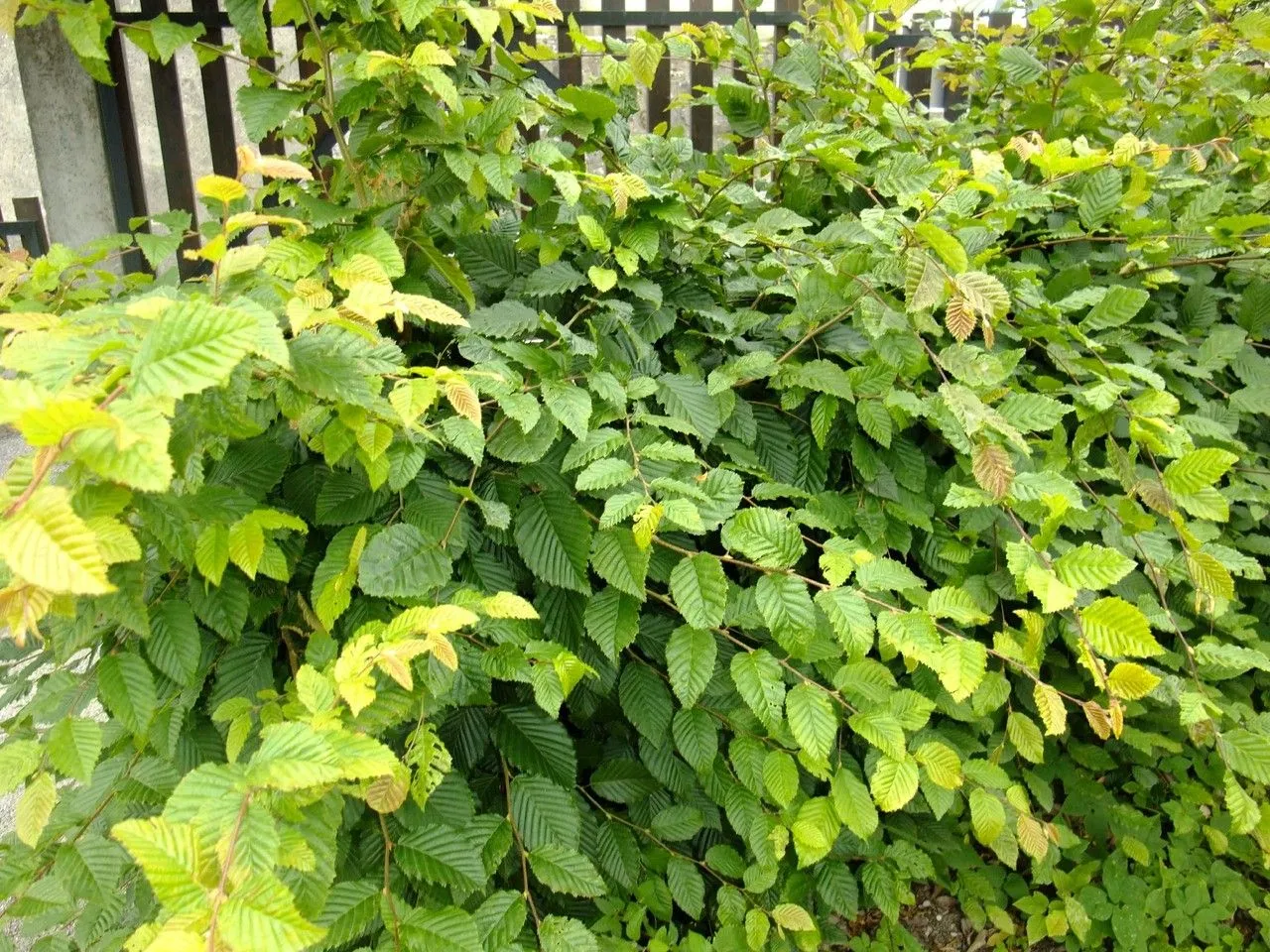
Author: Walter
Bibliography: Fl. Carol.: 236 (1788)
Year: 1788
Status: accepted
Rank: species
Genus: Carpinus
Vegetable: Unknown
Observations: E. Canada to SE. U.S.A.
Musclewood, scientifically known as Carpinus caroliniana, is a deciduous hardwood tree that is renowned for its characteristic smooth, gray bark, and muscular-looking ridges, hence the common name. This appearance often makes it resemble a flexed muscle, gaining it a spot among the more visually intriguing trees in its native habitats.
It belongs to the family Betulaceae and finds its origins meticulously documented in Walter’s “Flora Caroliniana” dated 1788, an authoritative text on the flora of North America.
Musclewood primarily inhabits a range stretching from eastern Canada down through the southeastern United States. Its geographic resiliency is quite notable; the tree thrives in the rich, moist soils typically found in the understory of deciduous forests. It prefers moist, well-drained sites and can often be found near streams and rivers, contributing significantly to the ecological diversity of these riparian zones.
The leaves of Carpinus caroliniana are simple and alternately arranged, featuring a doubly serrate margin which adds to its textural appeal. In the autumn, the foliage transitions to vibrant shades of yellow and orange, enhancing the seasonal diversity of forest canopies. The tree’s flowers are catkins, with distinct male and female flowers on the same plant, typical of members in the Betulaceae family.
Though not one of the towering giants of the forest, Musclewood usually reaches heights of about 20- 40 feet, making it an excellent choice for smaller landscapes and garden settings. Its wood, while not broadly commercialized due to the tree’s relatively small size, is known for being extremely hard and dense. This makes it useful in specific applications requiring durable hardwood.
Ecologically, Musclewood serves as a valuable species. Its dense foliage provides cover for various bird species, and the seeds, which are small nutlets encased in leafy bracts, are a food source for wildlife including birds and small mammals.
This remarkable tree demonstrates an admirable blend of aesthetic charm and ecological utility, making it an asset to both natural and cultivated landscapes.
Eng: american hornbeam, blue-beech, ironwood, musclewood, water-beech, blue beech, hornbeam
Swe: amerikansk avenbok
Fra: bois de fer, charme de caroline, charme de la caroline
Spa: alisillo, capillero, caxin, c’ut bah té, dsuram cura, lechillo, mora blanca, mora de la sierra, moralillo, oreja de ratón, palo barranco, palo blanco, palo borracho, palo liso, palo de barranca, pepinque, pipinque, tzaráracua-ucua, tzutcamay
En: Musclewood, Water-beech, American hornbeam, Blue-beech, Ironwood, Blue beech, Hornbeam
Be: Граб каралінскі
Ca: Càrpinus de Carolina
Fi: Amerikanvalkopyökki
Fr: Bois de fer, Charme de Caroline, Charme de la Caroline
De: Amerikanische Hainbuche
Hu: Amerikai gyertyán
Nv: Kʼiishzhinii (tsin)
No: Amerikaagnbøk
Pl: Grab amerykański
Ru: Граб каролинский
Es: No conocido, Mora blanca, Mora de la sierra, Moralillo, Oreja de ratón, Palo barranco, Palo blanco, Palo borracho, Palo liso, Tzaráracua-ucua, Alisillo, Capillero, Caxin, C’ut bah té, Dsuram cura, Lechillo, Palo de barranca, Pepinque, Pipinque, Tzutcamay
Sv: Amerikansk avenbok
Tr: Amerika gürgeni
© copyright of the Board of Trustees of the Royal Botanic Gardens, Kew.
Taken May 10, 2019 by Emilio Herrero (cc-by-sa)
Taken May 1, 2022 by 8 8 (cc-by-sa)
Taken Jun 7, 2022 by bri moyers (cc-by-sa)
Taken Sep 10, 2021 by natacha martin (cc-by-sa)
Taken Jul 26, 2011 by Tela Botanica − Yoan MARTIN (cc-by-sa)
Taken Oct 17, 2020 by Danielle Rousseau (cc-by-sa)
Taken Jun 12, 2022 by Jesse kalfel (cc-by-sa)
Taken Jun 2, 2021 by J Lynn (cc-by-sa)
Taken Jul 26, 2011 by Tela Botanica − Yoan MARTIN (cc-by-sa)
Taken Jul 27, 2022 by Bohdanna Gott (cc-by-sa)
Taken Mar 28, 2022 by Maarten Vanhove (cc-by-sa)
Taken May 1, 2021 by Eli Small (cc-by-sa)
Taken Oct 11, 2020 by catherine white (cc-by-sa)
Taken Apr 27, 2021 by Carlos H (cc-by-sa)
Taken Jul 26, 2011 by Tela Botanica − Yoan MARTIN (cc-by-sa)
Taken Jun 12, 2020 by Franklin Barrett (cc-by-sa)
Taken Jul 27, 2020 by Danilo Diedrichs (cc-by-sa)
Taken Jun 11, 2021 by Michel Chevalier (cc-by-sa)
Taken Jun 23, 2021 by Alexa Gianinio (cc-by-sa)
Taken Sep 10, 2021 by natacha martin (cc-by-sa)
Taken Aug 19, 2022 by Michel G (cc-by-sa)
Taken Jul 16, 2021 by jake kristophel (cc-by-sa)
Taken Jul 18, 2021 by Andy (cc-by-sa)
Taken Jul 20, 2020 by Xeno onex (cc-by-sa)
Family: Myrtaceae Author: (F.Muell.) K.D.Hill & L.A.S.Johnson Bibliography: Telopea 6: 402 (1995) Year: 1995 Status:…
Family: Rubiaceae Author: Pierre ex A.Froehner Bibliography: Notizbl. Bot. Gart. Berlin-Dahlem 1: 237 (1897) Year:…
Family: Sapindaceae Author: Koidz. Bibliography: J. Coll. Sci. Imp. Univ. Tokyo 32(1): 38 (1911) Year:…
Family: Asteraceae Author: A.Gray Bibliography: Pacif. Railr. Rep.: 107 (1857) Year: 1857 Status: accepted Rank:…
Family: Fabaceae Author: Medik. Bibliography: Vorles. Churpfälz. Phys.-Ökon. Ges. 2: 398 (1787) Year: 1787 Status:…
Family: Aspleniaceae Author: (Cav.) Alston Bibliography: Bull. Misc. Inform. Kew 1932: 309 (1932) Year: 1932…